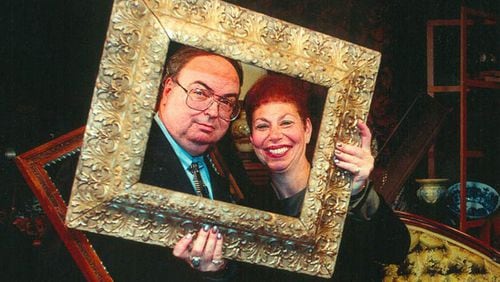Dear Helaine and Joe:
The enclosed photographs show some of the tumblers in my collection. I would appreciate anything you can tell me about them.
Thank you,
C. A.
Dear C. A.:
The first thing we wonder is if this is your entire collection or just a selection of examples within the collection. The next question we have is the intent behind your inquiry — do you want to insure these? Or do you want to sell them?
Most of these tumblers are from the late Victorian era, but a few are more modern. We suspect very strongly that the blue coin spot pitcher and six matching glasses are second quarter of the 20th century and possibly made by the Fenton Glass Company of Williamstown, W.Va.
The company was founded in 1905 and is said to have been the inventor of carnival glass. But they also made a wide variety of other glassware, including these pieces, in the coin spot pattern. Fenton closed in 2011. It is our understanding that the historically important plant is being demolished to make way for an elementary school.
We have seen these pieces referred to as being “blue dot,” but coin spot is more classically correct. If the set of six tumblers and matching pitcher were sold at auction, it would probably bring somewhere in the $125 to $150 range and should be insured for $250 to $300 (if all pieces are in perfect condition).
Some of the other tumblers owned by C. A. are sweet-looking floral enamels on a transparent, colored background (such as amber, cranberry or blue). These were all hand painted and probably produced in either England or the region known as “Bohemia,” which is now part of the Czech Republic.
They are very common and collectors pay more for cranberry than they do for the other hues. Unfortunately, an amber tumbler with this type of decoration might bring less than $10 each at auction, and retail for less than $25. Blue brings a little more while the cranberry examples may sell in the $20 to $25 range at auction and should be insured in the $40 to $50 range (if the condition is perfect).
We notice that C. A. has at least two so-called “Mary Gregory” tumblers, which feature images of children rendered in white enamel against a colored background. Here the value depends not only on the color of the glass but also on what the child happens to be doing. Blowing bubbles, chasing butterflies with a net, holding a butterfly on a finger and rolling a hoop are all popular themes.
The real Mary Gregory was an artist at the Boston and Sandwich Glass Company, but she never made this type of glass. Instead, Mary Gregory glass was largely made in Bohemia. Single, rather typical examples like the ones owned by C. A. should be valued at auction in the $20 to $45 range each — with retail values in the $45 to $90 range. But beware, many, many reproduction of this sort of glass do exist and can be real foolers.
———
Helaine Fendelman and Joe Rosson have written a number of books on antiques. Do you have an item you'd like to know more about? Contact them at Joe Rosson, 2504 Seymour Ave., Knoxville, TN 37917, or email them at treasures@knology.net. If you'd like your question to be considered for their column, please include a high-resolution photo of the subject, which must be in focus, with your inquiry.






